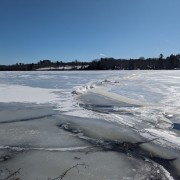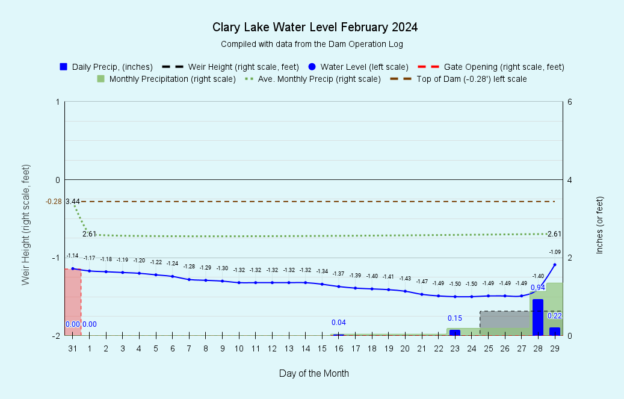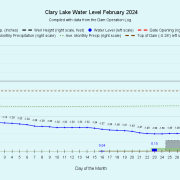I have archived the February 2024 water level chart (above, and at left). There was virtually no precipitation to speak of in February until the last 2 days of the month when we received a total of 1.16″ of rain! We ended the month with only 1.35 inches total, or only 52% of the normal 2.61 inches. On average, February has the least amount of precipitation of all 12 months. Despite the lack of precipitation, the lake level actually fell quite slowly over the course of the month losing only 0.36 feet all month while outflows remained quite high, thanks to January’s excessive rainfall. In fact, for much of the month of February total outflows in acre-feet exceeded those in 2023 which is amazing considering how little precipitation we received. By the end of the 3rd week of February however, outflows had fallen behind 2023 numbers and the lake level finally reached -1.5 feet. With slowing outflows, we decided it was time to add some stoplogs to the weir. The rainfall at the end of the month brought the lake up 4 tenths of a foot, ending the month at -1.09 feet or about average for the end of February. I expect the lake will rise a little more in the next couple of days.
Outflows and Ice Cover
 Total outflows so far this year, while lagging behind 2023 a bit, are still quite high compared to the last 5 years for this date (see chart at left). Historically, years with high outflows tend to correlate with better lake water quality, though this isn’t by any means a hard and fast rule, and it’s still very early in the year to try and make any predictions. Outflows can also change drastically depending on the weather. Much of the water leaving the lake this winter has been ground water, seeping into the lake to replace what’s lost downstream. That’s why the lake level has fallen so slowly this winter despite the high outflows.
Total outflows so far this year, while lagging behind 2023 a bit, are still quite high compared to the last 5 years for this date (see chart at left). Historically, years with high outflows tend to correlate with better lake water quality, though this isn’t by any means a hard and fast rule, and it’s still very early in the year to try and make any predictions. Outflows can also change drastically depending on the weather. Much of the water leaving the lake this winter has been ground water, seeping into the lake to replace what’s lost downstream. That’s why the lake level has fallen so slowly this winter despite the high outflows.
 One thing the high outflows have definitely affected this winter is the ice cover on Clary Lake: moving water tends to hamper ice development as does warming temperatures. Reports of ice thickness have ranged only from 5 to 6 inches this winter- a far cry from the 18″ I remember as a boy. Also, on this leap day, February 29, 2024, I can already see a band of open water on the north shore over by Young’s Point, at the end of Duncan Road and the seam in the ice running from Grants point across to Hodsdon’s point is still open (picture at left) and getting wider. You can even see a little open water close to shore on webcams 2 & 3. It’s all pointing to an early ice out this year, and judging from the guestimates on the 2024 Ice Out Contest, many people think so too. I’ve closed the contest to new guesses.
One thing the high outflows have definitely affected this winter is the ice cover on Clary Lake: moving water tends to hamper ice development as does warming temperatures. Reports of ice thickness have ranged only from 5 to 6 inches this winter- a far cry from the 18″ I remember as a boy. Also, on this leap day, February 29, 2024, I can already see a band of open water on the north shore over by Young’s Point, at the end of Duncan Road and the seam in the ice running from Grants point across to Hodsdon’s point is still open (picture at left) and getting wider. You can even see a little open water close to shore on webcams 2 & 3. It’s all pointing to an early ice out this year, and judging from the guestimates on the 2024 Ice Out Contest, many people think so too. I’ve closed the contest to new guesses.


